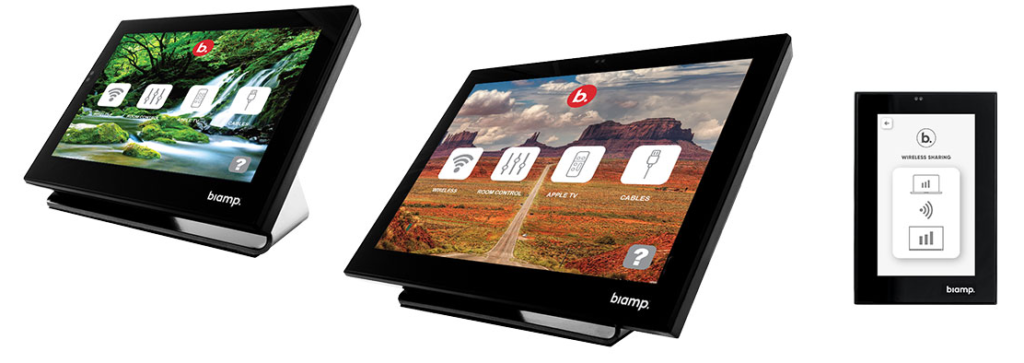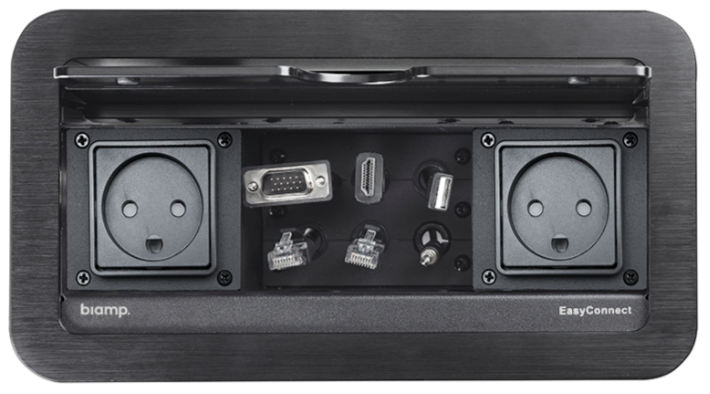Focused. Professional. Effective. These are three words people use to describe what they consider to be a ‘good’ company or business. Companies and brands try their best to communicate these values at most major touchpoints.
But one often-overlooked touchpoint is a company’s meeting or conference facilities; the spaces guests (clients, suppliers, partners, and others) visiting the company are likely to be in.
The conference room is a place where you can score some easy points when conducting business
Let’s face it, a lot of conference rooms are inadequate. Sure, there is coffee and snacks and the chairs are really comfortable, but when it comes to actually using the room for its intended purpose – getting the slide deck to appear on the screen, getting the audio to work, connecting to remote participants – the conference room often is where awkward and frustrating experiences occur.
On the other hand, having a conference room that works without stress and hassles (regardless of whether it’s being used for online or offline meetings–or a combination) is an excellent way of helping your employees stay focused on the job at hand: leading an effective meeting that yields positive results. A meeting that runs without technical issues makes a great first impression and sends a signal that you’re a no-nonsense type of company where things are streamlined and effective. In other words focused, professional and efficient.
So, say goodbye to anger-inducing conference room experiences and read on to learn more about the tools and products you need to create the most productive environments.
AV control systems – the possibilities
Integrating an AV control system is a smart way of managing display screens, audio, lights and any other devices in the room automatically. AV control systems–which come in several forms and can handle various levels of complexity–are the brains behind an AV system. Some basically look like black boxes with wires and cables coming out, others look like keypads, and others have a touch panel interface the size of a smartphone or tablet.
A control system is normally installed by a professional AV integrator and can be configured to perform all sorts of functions. These functions are determined by the needs of individual clients and their equipment setup. Some examples of functions are:
- Turning the display screen on and off
- Turning the volume up and down
- Rolling a projector screen up and down
- Turning a projector on and off
- Turning a webcam/microphone on and off
- Connecting to a signal, for example, a laptop, as soon as someone plugs in an HDMI / USB cable
- Automatically turning a display screen or projector on as soon as a laptop is connected with a cable
This setup ensures that all the equipment in a conference room can be controlled from one central location with just one device. Another advantage is that you can have several laptops connected simultaneously; you can simply switch between signals with the push of a button. No more wasting time downloading everyone’s presentations onto one laptop, people switching seats and pulling cables in and out when it’s their turn to present. In a situation where several people need to present something on-screen, the whole setup suddenly becomes a lot more streamlined and efficient.
There are several types of AV control systems, varying in size, price range and complexity. allowing you to find the solution that works for your room and your needs. In an extremely digitalized workplace, technology is playing a more important role than ever, and it’s important to use it to your advantage.
Touch panels – an elegant AV control solution
Keypad control systems are excellent choices for smaller rooms or learning spaces. However, if you prefer a solution with smarter tech and a more exclusive look, a touch panel is probably the best option. A touch interface is much more powerful than a keypad and allows you to perform more complex functions than pushing a button. A keypad is limited to performing the same number of functions as the number of buttons. A touch panel gives you many more possibilities. A professional AV integrator can design a touch panel interface to have several ‘layers’ of functions, making it a perfect solution for rooms where many different types of AV equipment are used.

Cable management tech – eliminating cable chaos
One of the most effective ways of ensuring your conference room looks organized and professional is to invest in a cable management system. Nothing looks worse than a room with cables and wires draped over chairs and tables and trailing all over the floor. It looks untidy and chaotic and makes life difficult for the people who use the room. Cable chaos makes it hard to figure out which devices the cables belong to, which are the right cables to use, etc.
Several types of tech products and accessories can help you bring order to the cable chaos. Some display screens, projectors and speakers can be connected to wireless streaming devices, apps or even Bluetooth. Most people, however, still connect to these devices the traditional way: using cables. This means there are usually several cables trailing down walls and hanging down from the ceiling. Few people think this looks particularly nice. It can also be very impractical if someone trips over the cables and disconnects them by mistake (not to mention a possible violation of corporate health and safety policies).
There is a solution, however. You can conceal wires and cables by having specially designed wall plates installed. These provide you with a way to connect a laptop to other devices (such as display screen/projector/sound system) in an elegant way, without having cables dangling all over the place. Such an installation would be conveniently located on the wall close to where you sit with your laptop, where all that’s needed is a short cable to connect to the required device. Panels are available with different types of inputs: USB, HDMI, VGA, AUX, etc. The type of input depends on the type of device you are connecting.
Another solution is installing a table well, which passes power cables and other necessary connections through a conference room table or other work surface for easy and quick access. The cables are retractable, so they are hidden when not in use. More advanced versions of table wells contain an AC power connector, standard cable connectors (such as USB, HDMI, audio minijack and an Ethernet cable) and a keypad control system so everything is managed directly from the desk or conference room table.
Cable management adds the final touch to a conference room AV solution, making the room look more elegant, visually appealing and user-friendly at the same time.

Eliminate logistical nightmares with conference room booking systems
The logistical nightmares associated with double-booked rooms and the hunt for a free conference room can be eliminated with smart tech products. Imagine having led a client to the meeting room you booked, only to walk in and find another team in the middle of their meeting! It’s embarrassing and unprofessional, distracting and time-consuming.
So, consider investing in one of the many meeting room booking solutions on the market. There are many benefits to installing such a system:
- Users will not need to learn how to use another app/software. Most conference room booking systems integrate with email and calendar systems such as Microsoft Outlook or G Suite, meaning users can book meeting rooms through familiar software.
- Maximize resources. It can be very frustrating for employees to see that meeting rooms are booked in the system, only to walk past and see many of them empty because the meeting was cancelled. Some booking systems also have a check-in function, meaning that meetings are cancelled automatically after a certain amount of time, freeing up the room.
Of course, a meeting/conference room booking system requires a physical product – typically a touch panel or tablet – outside the room to show the room availability. Available rooms can also be booked directly from the touch panel.
Conference room design that supports technology
All the solutions we have described can help you make your conference room smarter. Of course, it’s important to have the right layout, design and furnishings in the room to support your smart tech system. It would be a pity to install the best products the AV tech world can offer, only for people to sit uncomfortably or be unable to hear properly because of poor design and acoustics. Every aspect of the conference room should reflect quality. Technology, interior design and all the other small but important details contribute to a positive overall experience. Ugly or uncomfortable chairs could be the one thing guests remember when they leave the conference room, despite all the smart tech.
Conference room layout and design play a huge role in a meeting’s overall experience. The conference room’s design must match the room’s purpose.
For example, if the room is meant to be used for video conferencing:
- the conference room table must be the right shape and size
- the webcam and microphones must be placed in strategic locations so all participants are seen and heard clearly
- lighting (lights and curtains) must be adjustable to ensure optimal conditions
- Distracting elements, such as the conference room door, should not be visible through the webcam
Concluding thoughts
In this article, we gave you an overview of 5 products we believe are must-haves in any type of meeting room or conference room. These solutions will transform participants’ meeting experience, changing conference rooms from places people dread to be in to places where people feel confident, focused, and ready to be productive.
